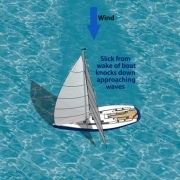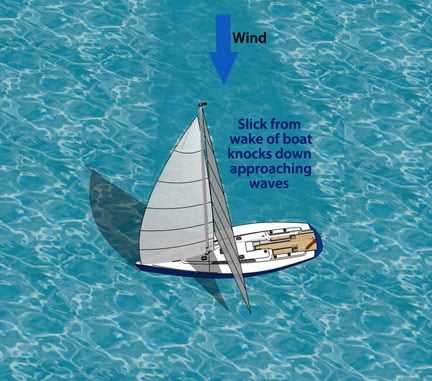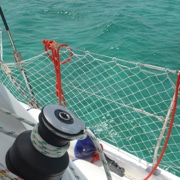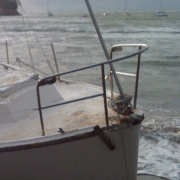Heaving To in a Sailboat is a Practiced Skill
How to Heave To
The books simply say to tack the boat and leave the head sail cleated to windward and turn the wheel all the way to windward (tiller to lee). While that’s correct, there are a lot more things to think about to pull it off correctly. This article is part of the training in the Skipper Sailing Course and is written by Grant Headifen, the Educational Director.
There are a few reasons you might want to heave to.
- Lunch, simply taking a rest, or instructor debriefing
- Storm Tactics and Reefing
- Man over board recovery
- Boarding by another vessel (ie, crew change during a race, or law enforcement safety inspection)
A Cool Trick about Heaving to!
The first thing to think about is (if you can) lie in a heave-to position so that your boom is on the port side. Why? So that you’re technically sailing “on starboard tack”, putting you in a more advantageous stand-on position with regard to the Navigation Rules vis-a-vis other sailboats “on port” tack. Wouldn’t want to disturb our lunch now would we? It’s not a big deal but just something most people may not have thought about.
What is Heaving To?
When you are successfully hove-to, your sailboat will be in a stable situation with the mainsail and headsail still up. Your forward speed will be minimal and you’ll be sliding downwind slightly. This makes it an ideal strategy for the situations above. Essentially you’re under full sail but nearly stopped! Cool eh?
How Heaving to works
The mechanics of the heave-to situation is that the forward speed of the boat has dropped to a minimum because the head sail is back winded (aback) and the main sail has been eased out far enough to reduce nearly all of the forward driving lift on the sail. The backwinded head sail creates a large turning moment on the boat to turn it downwind. As the boat turns downwind however the boat tends to pick up a little speed. As the boat picks up a little speed, the windward locked wheel causes the rudder to turn the boat back upwind, killing off the speed. It creates a little see-saw action. You can adjust the see-saw action by adjusting the set of the headsail, the mainsail, and the rudder angle. Each boat will see-saw a little differently in differing wind conditions and due to the distances of the rudder and the headsail center of pressure positions around the hydrodynamic pivot point of the vessel. Once the boat is settled, by making small adjustments to the angle of the rudder, the amount the mainsail is eased, and by the “depth” or flatness of the headsail, a skilled operator can make very useful adjustments to the exact way in which the boat is lying to the wind and seas. Practice practice practice! When that storm comes, you’ll be glad.
How to Heave To
Once you’ve got it down, you’ll enjoy having this little skill under your belt but you’ve got to practice it a few times. To enter into a hove-to position, if practical, start out on a on a port tack with the headsail sheeted in tight. Tack the boat slowly onto a starboard tack (bleeding off some speed while head-to-wind) but leave the headsail cleated (ie don’t tack the headsail). Turn the boat so that you’re on a close reach (60 degrees off the wind) and let out the mainsail most of the way out so that it is luffing. Now wait until the rest of the boat’s headway speed bleeds off. That’s the key part. If you turn the rudder to windward (the wheel to windward or the tiller to leeward) before the speed bleeds off, the momentum of the boat may carry it through another tack. Once the speed has bled off, turn the rudder all the way to windward (wheel to windward or tiller to leeward) and lock it in that position (lashing the tiller).
Heaving to in a Storm
It’s really important to realize that this is a completely wise thing to do in a storm. With a huge caveat, make sure you have plenty of sea-room distance to leeward on the track of your hove-to reckoning, avoiding shoals, or the other hard stuff (like land!). Heaving-to in a storm gives you and your crew a rest from the elements. And it can be a safer means of riding out a storm rather than trying to sail it out. The boat is in a completely stable position. You should probably lower or deeply reef the main or raise a storm trisail (very small mainsail) as well as a small headsail to reduce loads on the rig. Here’s the kicker that is really cool – since the boat will be slipping sideways, a wake is left to windward. Any breaking waves hit this “slick” and flatten out, thus reducing the wave action on your vessel. Now that’s really cool.
A Heave To Must
When you’re settled down into the heave to position and every thing is balanced, use a preventer line to “prevent” the boom. This will prevent the boom from slapping around wildly with sudden variable gusts, save wear on the rig, prevent an accidental gybe or worse yet a bonk on the head if you need to go forward.
Using Heaving to in a Man Overboard Situation
Heaving to can be a very effective crew over-board recovery technique. The very moment the victim goes over the side you can crash tack the boat and go into a heave-to position. You must be sure that the victim is able to swim, that they did not sustain injury whist falling. It’s your call on this one but it’s a technique not often taught and so isn’t considered in the panic but, it will keep you from getting too far away from your friend in the water which is clearly the biggest danger. Me? I’d still get the engines on. On that topic, the biggest danger they say from turning on the engines is not chopping your friend up, you’re smart enough not to do that, it’s from getting a line wrapped around the prop in all the panic. So just make that’s part of your “engines-on” routine in crew over-board practice. Next time you’re out practice man (or woman) over board.
There you have it, you’re now a heave to expert. NOT! You haven’t practiced it enough yet! And while you’re out there practicing it, have fun. Or should it be the other way around???







